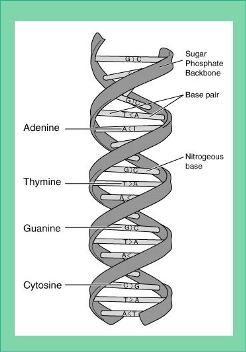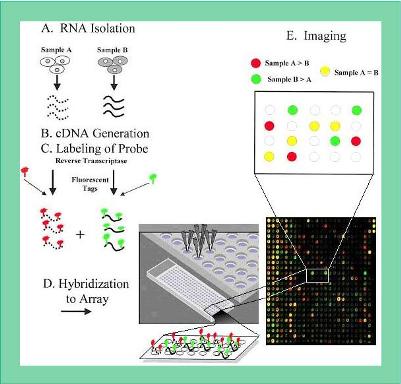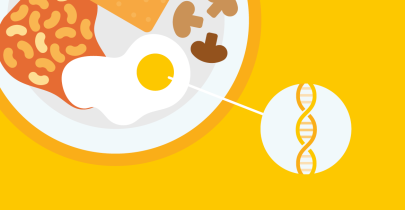Nutrition and the genome: A new chapter in health and disease
Last Updated : 03 February 2003Foods that are safer and more nutritious, new medical treatments and novel ways to help save the environment – these are just some of the many potential benefits that are expected to be derived from research into genes and how they function.
1. INTRODUCTION
While it has been known for some time that diet and specific nutrients can affect the gene functions, new research is expected to greatly advance our knowledge of nutrition and health. With the arrival of the first draft of the human genome, a whole new chapter on genetics, health and nutrition will be written. Research in this area has accelerated since the unravelling of genes in humans because scientists can now identify the various ways in which diets and nutrients affect individuals and how our genes are turned on or off by what we eat.
In February 2001 two independent teams of researchers raced against the clock to simultaneously publish their findings in two of the world’s most prestigious journals – Nature and Science. The first “rough draft” of the human genome had been unravelled. This is an achievement nothing short of astonishing when one considers that the complete sequence of the human genome consists of 3.2 billion letters and is so enormous that it can only be published in data bases on the Internet. It has been estimated that it would take more than 75,000 pages of a newspaper just to print the full sequence!
The entire sequence of the human genome is expected to be completed by 2003 yet this will only signal the beginning of increased activities into identifying specific functions and interactions of genes in an effort to unlock the enormous potential of genetic information. Research on the human genome has been painstaking and exacting, requiring an in depth knowledge of cell function and reproduction. The following paragraphs very briefly and simply review current understanding of the structure and function of various aspects of the human genome.
2. UNDERSTANDING DNA
2.1 DNA structure and function
Cells are the fundamental units of all living systems. We are all made up of billions and billions of cells, but each has the information necessary to make a new entire human. This is possible because all of the information and instructions needed to make a human are encoded in a single group of molecules called deoxyribonucleic acid (DNA). DNA is found in the nucleus of the cell. In humans, and all higher species, a DNA molecule consists of two strands of DNA, which wrap around one another to resemble a twisted ladder (Figure 1). The sides of the ladder are made up of sugar and phosphate molecules (deoxyribose) while the rungs consist of chemical compounds called bases.
DNA encodes an information language made up of just 4 letters, which are termed chemically, bases. In the DNA molecule the two strands are mirror images of each other because each base in one strand is matched to a specific partner on the opposite strand. Adenine (A) is paired with thymine (T), and guanine (G) is paired with cytosine (C).
All of the information needed for a cell to function or reproduce is encoded in the sequence of these four bases. This sequence extends for billions of bases along the genome. Every life form on the planet uses this same language and hence, the particular order of the bases – adenine, thymine, guanine and cytosine – is important because this is what makes a human a human, rather than an earthworm. In other words, it is the sequence of bases that underlies the diversity of organisms. Imagine the possibilities made possible by this biological constant. All organisms use the same language to store all of the information needed to create them. The DNA sequences hold the secret of every life form from bacteria to humans, and science has now decoded these books of life called genomes.
FIGURE 1: Deoxyribonucleic acid (DNA) structure.

2.2 What is a genome?
A genome consists of the entire DNA sequence of an organism, including, of course, its genes. Genomes vary in size depending on their source. For example, the small genomes from bacteria have approximately 600,000 DNA base pairs (bps). The human genome has about 3 billion base pairs.
While genes get a lot of attention, the actual workhorses are the proteins. Genes carry information to enable the cell to make thousands of proteins. The proteins in turn determine a whole host of features such as what the organism will look like, how well it functions and perhaps even how it behaves.
When a cell needs to use a particular piece of information, the appropriate section of the double-stranded DNA molecule is opened like a zipper, and one of the strands is used as a template to synthesise a new molecule called “messenger ribonucleic acid (mRNA)”, by a process called transcription. mRNA is a long single stranded molecule that resembles a comb. It is made up of ribose (a sugar) and phosphate molecules with one of the four chemical bases attached to each ribose chain. The sequence of bases on mRNA but here consisting of uracil, adenine, guanine and cytosine is the same as the section of DNA that was used to create it. mRNA carries the DNA’s message out of the cells’ nucleus where it can be used to make proteins.
3. THE HUMAN GENOME
The human genome is enormous. If the DNA molecules in just one human cell were stretched end-to-end they would be approximately 2 molecules wide and 5 feet long. A 1 mm thick thread of equivalent proportions would be 1000 km long. This DNA is arranged in 23 units or chromosomes, each chromosome occurs as a pair of 2 with one chromosome donated by each parent. In the simplest terms, a gene corresponds to a section of the DNA molecule that codes for a protein. In the human genome the genes are spread throughout the various chromosomes, and although all 3 billion bases of the human are now known, scientists do not yet know precisely all the genes. This information is the basis of ongoing research.
Research using the knowledge from the Human Genome Project will ultimately enable scientists to understand the functions of human genes and the laws that regulate how they are turned on and off. This knowledge in turn will provide them with information on how genes and nutrients interact and the effect of individual genetic differences on diet, nutrition and health. For example, the actual way in which some nutrients such as those from milk, fruits and vegetables, produce desirable changes in metabolism is largely unknown, which is why dietary recommendations are still so frustratingly vague. The study of nutrigenomics can help to identify these effects and help to understand why certain ingredients and foods are of benefit to health. Similarly, the genetic basis behind the differences in how some people respond to particular foods and nutrients can be identified and used to recommend foods and diets that are most beneficial for each individual.
Nutrigenomics will also help to provide new information for developing more accurate biomarkers (indicators) to detect various diseases much earlier and identify the genes that can be targeted by nutritional intervention to prevent them.
4. POTENTIAL BENEFITS OF RESEARCH INTO GENES
4.1 More nutritious foods
Research into the functions of genes will help to identify just how diet affects gene and protein functions and why individuals vary in their response to nutrients and diets. We all know that even when people are eating the same diets, some will develop overweight, some develop heart disease and some develop allergies while others do not. Wouldn’t it be wonderful to know why? This knowledge can help in the development of even more nutritious foods. Specific foods with beneficial properties (functional foods) could then be developed to help optimise the health of each individual according to its genes. This may seem far in the future, but we already eat foods according to our genetic differences. Women know that they need to eat foods with more iron than men do and the difference in iron requirement is due to their genetic difference. As we understand more about the other differences between men and women and between all of us, we can provide the knowledge to individuals so that they can choose foods that are most appropriate for them. For example, knowing how individuals develop allergies would lead to foods not simply to avoid allergens but foods that prevent people from even developing allergies in the first place.
One of the most intriguing areas of research, that will eventually help everyone, is understanding the processes of ageing and diseases of the elderly. Scientists have found that about half of the diseases that come with ageing have a genetic component. Substances in foods can influence some of these functions so the potential exists to identify dietary ways to delay ageing or to promote healthy ageing.
Genetic research can help in identifying ways to develop functional foods to deliver benefits that we hadn’t even thought of until recently. One example is the role of certain bacteria in intestinal and overall health. Imagine eating bacteria to make you feel better! Genetic research will help to understand why certain bacteria (for example lactic acid bacteria), have beneficial properties such as enhancing immune functions, assisting digestion and improving intestinal comfort. A greater knowledge of the types of beneficial bacteria and the way in which they act in the digestive tract to provide protection from other bacteria can also improve our ability to minimise harmful bacteria and foodborne illness. The expected benefits are better tasting, safer and more nutritious foods.
4.2 Individual diets
Although public health policy currently dictates one generalised set of dietary guidelines for all of the population, one size does not necessarily fit all. There are many examples of how individuals respond differently to diet. For example, vitamin and mineral needs vary between individuals and by age, condition, health, etc. The effects of consuming phytochemicals, such as isoflavones and other flavonoids, or even starch, differs from person to person. Sodium increases blood pressure in some people but not others and the ability of dietary fibre to reduce cholesterol is also subject to genetic influences.
The time is approaching when it will be possible to use genetic testing to screen for the risk of various diseases and to determine an individual's ideal health promoting diet. It will become commonplace for health care professionals to deliver tailor-made drug advice based on an individual’s genetic information. Similarly, it will be possible to deliver dietary advice more precisely. Better knowledge on the functions of genes and their variation does not mean that we have to measure someone’s genes to allow them to take advantage of this knowledge. After all you don’t need a genetic test to know what sex you are! By the same token, a person won’t need to know their genetic variations in order for them to select diets that improve their health. Simple blood tests that provide now for such things as cholesterol will provide much of the assessment necessary to deliver more precise dietary advice.
4.3 Food processing
Another potential use of research into the functions of genes is to improve food processing of the raw materials of foods, plants, animals and micro-organisms. These raw commodities can be selected for optimal levels of various nutrients or to make processing easier, or more economical, or safer or even more nutritious. In fact, commodities will be selected to have better nutrients and better processing and safer and better flavour and more value. As a simple example, potatoes with higher levels of starch could be developed that when processed into potato chips or french-fries, would absorb less fat offering the choice of a low fat potato chip. Fruits and vegetables that have delayed ripening properties could be grown so that they can be transported more easily with less damage and arrive in stores fresher and tastier.
Many genes contribute either directly or indirectly to the flavour of a plant. Scientists can identify and study the genes responsible for flavour and aroma and use the information to improve the taste of foods.
Improved food safety is a key area that will benefit from research into genes. Fast and sensitive techniques are being developed to identify unwanted food-poisoning bacteria and other contaminants in foods. Several techniques have already been applied to improve quality control procedures. Using techniques developed via genetic research, it will be possible to study the physical, chemical and microbiological responses of various foods during processing, transport and storage. This in turn can help to identify optimal processing and handling conditions to help ensure a safe and desirable food product in the marketplace.
4.4 Improved diagnosis of disease
It has been known for centuries that many diseases have a genetic component. Scientists have already identified more than hundred genes linked to diseases such as breast cancer, muscle disease, deafness and blindness.
Information from the human genome, in conjunction with powerful microarray techniques (see annex), is making it possible to identify the exact gene (or genes) that influence a person’s susceptibility to the diseases linked to diet. These techniques can also be used to screen large numbers of people for the presence of such genes. Once high-risk individuals are identified, measures can be taken to help prevent the disease or detect it early when treatment methods are most effective. In the case of dietary-related conditions, these interventions will involve dietary changes and/or the inclusion of functional food components. This principle has already been the basis of life saving treatments of humans with a rare genetic disease phenylketonuria (PKU). Individuals with this disease cannot metabolise the amino acid phenylalanine so, for them, the amounts of phenylalanine normally present in foods is toxic. These people nevertheless now live full lives because special foods have been designed and produced just for them with no phenylalanine.
5. ETHICAL, SOCIAL AND LEGAL ISSUES
The huge potential offered by genome research is tempered by the ethical, legal and social challenges that must be addressed. One critical issue is privacy and fairness in the use of genetic information. Privacy of information on an individual’s genetic profile by groups such as employers, insurance companies, schools and adoption agencies must be absolute to preclude genetic discrimination. Several companies in the United States have banned the use of DNA testing in job applications in an effort to address this concern.
Some countries, such as Iceland and Estonia are taking a bold approach to develop genetic databanks of the whole population. Coupled with other data such as health statistics, this information has potential benefits in helping governments to determine future health policies and funding. However, the information is also of great interest to many third parties. A proper balance between individual privacy and the fair use of genetic information must be identified. In some countries, this may be covered by anti-discrimination regulations although the scope of such coverage has not yet been tested in the law courts.
The question of ownership of genetic information and technologies derived from genetic research is yet another area that requires deliberation and international debate. The EU European Group on Ethics and Science in New Technologies has been examining the issue of patents in agricultural genetic research and has introduced measures to govern fairness in this area (EU Council Directive 98/44/EC). The area of patenting in human genome research is still being addressed.
There are no easy answers to the above questions. Ethical, legal and social issues pose challenges as research into the human genome progresses. A great deal of work has already and still needs to be put into discussions and provide information to address these concerns and to foster public understanding of the technology so as not to slow scientific progress. One of the challenges will be to balance the multiple benefits that can be derived from the technology with careful protection from genetic discrimination.
6. THE WAY AHEAD
The importance and complexity of the interaction between food, genes and health poses a huge challenge to the future development of products, especially in the area of foods and food ingredients. Research in this area will enable the identification of new targets for pharmaceuticals and the discovery of new compounds. However, unlike pharmaceutical products that generally target one specific function or endpoint (such as cholesterol), the comprehension of the complex and multiple interactions between nutrition and genes will enable greater understanding of metabolic problems such as obesity and diabetes and the identification of new treatments.
As it becomes possible to assess an individual’s genetic susceptibility to disease, it will become possible to create special foods and medical treatments uniquely tailored to help manage that susceptibility. At the same time, these new technologies will spark profound ethical and human rights challenges. To derive the long-term benefits from a new technology such as this, society must balance the benefits with current scientific limitations and social risk. As with any new technology, the public must be educated about gene technology so that they can make informed choices.
Reviewed by Prof Dr. Hannelore Daniel, Technical University Munich.
ANNEX:
SCIENTIFIC TECHNIQUES TO STUDY DNA.
Unlocking the secrets of the human genome.
The key to unlocking the secrets of the human genome will be to understand how the individual genes function, how they are regulated and how the encoded proteins interact with one another. This is a daunting task when examining more than 30,000 genes and possibly 50,000 proteins.
FIGURE 2: Karyotype image

One way to study chromosomes is through a light microscope. Chromosomes can be stained with various dyes to reveal light and dark patterned bands. The patterns reflect the location and amounts of the base pairs – adenine and thymine, and guanine and cytosine. Differences in the size and banding patterns allow scientists to distinguish individual chromosomes. This type of analysis, called karyotype (Figure 2), has been used to identify major chromosomal abnormalities, such as Downs Syndrome.
Most changes in DNA however are too subtle to be detected by this technique. A new and more powerful analytical technique called microarray analysis offers researchers the benefit of being able to examine thousands of genes simultaneously. The process uses a gene “chip” which is composed of tiny spots of DNA from many known genes attached to a solid surface (like a glass slide) in a grid-like array (Figure 3).
To identify which genes in a sample of cells are active, their mRNAs are isolated (A) and converted in a test tube to another molecule called complementary DNA (cDNA) (B). A fluorescent label is then attached to the cDNAs (C) and the cDNAs are allowed to mix with the DNA spots on the array (D). The cDNAs with a sequence that matches the sequence of one of the gene fragments stick to the fragment like glue and the cDNA with a sequence that doesn’t match is washed away.
A computerized detector is used to measure the amount of fluorescence associated with each spot (E). The brighter the fluorescence, the more copies of the gene were expressed in the original cell. The patterns of light that emerge from the array represent a snapshot of the genes that were active in the cell at a single point in time.
Examination of the microarray results from different cells exposed to different conditions at different times will help scientists understand the basic genetics of normal and diseased cells. This information has the potential to dramatically increase our ability to understand and treat human disease..
Individual DNA
Microarrays can also be used to gather information about the genetic endowment of an individual. This technique works by exposing the microarray to a sample of DNA. This technique has the potential to screen people for a specific gene, mutation or any combination of genes. As more information about the human genome becomes available, it may be possible to screen entire populations for virtually any genetically derived trait – diseases susceptibility, intelligence, longevity and many many more..
Another technique called DNA amplification, makes it possible to analyse minute quantities of DNA, a method already used in forensic science. This technique takes advantage of the fact that DNA can be induced with specific chemicals to reproduce itself. By exposing a DNA sample to specialized enzymes and other chemicals, it can be induced to copy itself. The process can be repeated over and over to increase the amount of the DNA many millions of times in a matter of hours. .
DNA is a very stable molecule and a tiny sample that is many years old can still be examined. This allows for example to trace and reconstruct human evolution from the earliest hominids to the most modern homo sapiens sapiens. Moreover, even the genetic basis of diseases in prehistoric populations can be analyzed..
FIGURE 3: Schematic representation of the microarray analysis technique.

REFERENCES:
- Working Draft Sequence Analysis Papers, Nature, Feb 15, 2001.
- The Human Genome, Science, 291; 5507, Feb 16, 2001.
- Primer on Molecular Genetics, United States Department of Energy, 2001.
- United States Department of Energy, Human Genome Project www.ornl.gov/hgmis.
- European Parliament and Council Directive 98/44/EC, 6 July 1998. Official Journal L213, 30-7-98.
- Roberts MA, Mutch DM and German JB. Genomics: food and nutrition. Current Opinion in Biotechnology 2001,12:516-522.
- Mollet, Beat. For Better Health and Nutrition. Current Opinion in Biotechnology 2001, 12:481-482.
- Schiffrin EJ and Blum S. Food Processing: probiotic micro-organisms for beneficial foods. Current Opinion in Biotechnology 2001, 12: 499-502.
- Verrips CT, Warmoeskerken MMCG and Post JA. General introduction to the importance of genomics in food biotechnology and nutrition. Current Opinion in Biotechnology 2001, 12: 483-487.
- Van der Meer IM, Bovy AG and Bosch D. Plant-based raw material: improved food quality for better nutrition via plant genomics. Current Opinion in Biotechnology 2001, 12: 488-492.
- De Vos WM. Advances in genomics for microbial fermentations and safety. Current Opinion in biotechnology 2001, .
- Mercenier A, Wiedermann U and Breitender H. Edible genetically modified organisms and plants for improved health. Current Opinion in Biotechnology 2001, 12: 510-515.
GLOSSARY OF TERMS
-
Cell: The basic unit of any living thing. Chromosome: Structures that contain the genes. The human somatic cell has 23 pairs of chromosomes (46 chromosomes).
-
DNA: Deoxyribonucleic acid, contains the genetic information that cells need to replicate and to make proteins.
-
Gene: A subunit of DNA that encodes a protein and other elements.
-
Gene mapping: Identification of the locations of genes on a DNA molecule.
-
Genetic discrimination: Discrimination or prejudice against individuals based on a genetic difference. For example, discrimination against people who have, or are likely to develop, an inherited disorders.
-
Genetic marker: A gene or other portion of DNA whose inheritance can be followed. Genetic predisposition: Genetic (inherited) susceptibility to a disease. The disease may or may not actually develop.
-
Genetic screening: Testing a group of people according to their genetic differences in order for example to identify individuals at high risk of having or passing on a specific genetic disorder.
-
Genetics: The study of heredity.
-
Genome: The sequence of all of the genetic material in the chromosomes of an organism.
-
Genomics: The study of genes and their function. Junk DNA: Stretches of DNA that do not code for genes. This is called non-coding DNA.
-
Karyotype: A photo-image of chromosomes showing the number, size, and shape of each chromosome type. The karyotype can be used to map gross abnormalities Messenger RNA (mRNA): RNA that serves as a template for protein synthesis.
-
Mutation: A change or changes in a gene observed by differences in number, arrangement or sequence of bases.
-
Nutrigenomics: The study of the interaction between genes and nutrition and individual variance in response to dietary intake.
-
Polymorphism: Difference in DNA sequence among individuals that may underlie differences in protein function and health.
-
RNA (Ribonucleic acid): A single chain as a copy of the DNA containing ribose instead of desoxyribose and that important for protein synthesis and other cell functions.
-
Transcription: The process of copying information form DNA into new strands of messenger RNA (mRNA) that serves as the building device for the protein.
-
Translation: The process by which the instructions carried by mRNA are directed into the synthesis of proteins from amino acids.



